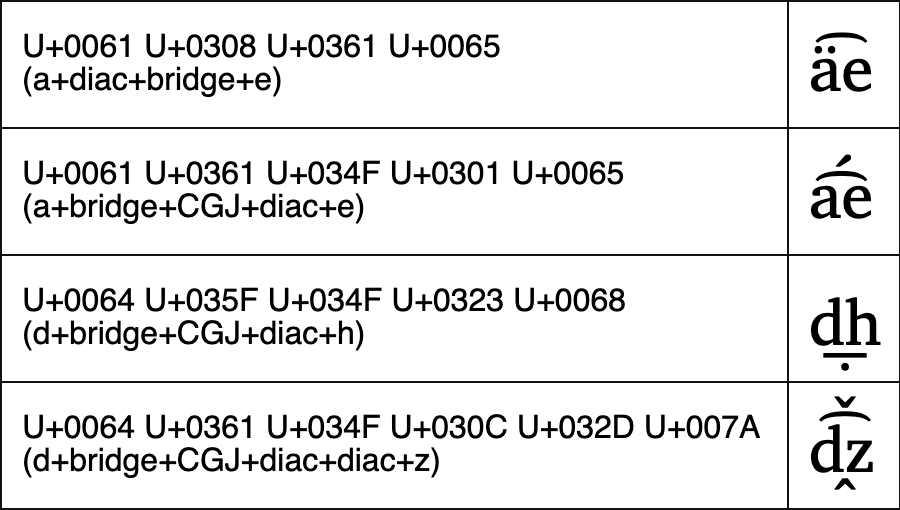Using Bridging Diacritics
Diacritics in many scripts, including Latin and Cyrillic, are commonly placed above or below a particular base letter, and their position is set related to that letter. There are a few less-common diacritics that are positioned between base letters and are intended to apply to letters on both sides. These bridging diacritics have different Unicode codepoints than their single-letter counterparts and require special handling in the font. Version 7 of the Charis, Gentium, Andika, and Doulos SIL fonts has improved support for these special bridging diacritics.
Special bridging diacritics
Unicode includes nine bridging diacritics that can be placed between characters:
- U+035C COMBINING DOUBLE BREVE BELOW
- U+035D COMBINING DOUBLE BREVE
- U+035E COMBINING DOUBLE MACRON
- U+035F COMBINING DOUBLE MACRON BELOW
- U+0360 COMBINING DOUBLE TILDE
- U+0361 COMBINING DOUBLE INVERTED BREVE
- U+0362 COMBINING DOUBLE RIGHTWARDS ARROW BELOW
- U+1DCD COMBINING DOUBLE CIRCUMFLEX ABOVE
- U+1DFC COMBINING DOUBLE INVERTED BREVE BELOW
Our fonts include one additional bridging diacritic in the SIL Private Use Area (PUA):
- U+F17A COMBINING DOUBLE DIAERESIS
Starting with the version 7 fonts these diacritics are raised and lowered as needed to accommodate letters with ascenders and descenders. They are centered on the boundary between the two letters rather than cluster as a whole, and their width does not take into account the width of individual letters. If the letters differ significantly in width from each other it may look like the bridging diacritic is misaligned. We’re unable to make these diacritics width-sensitive without considerable additional effort. If this is a significant problem for you please contact us.
Here are examples of bridging diacritics in Charis v7.000:

Positioning other diacritics between letters
Unfortunately there is no reliable method of positioning an arbitrary combining diacritic between two letters. The official bridging ones listed above are the only ones that are likely to work across a variety of operating systems, applications, and browsers. There is a partial workaround for this using U+200A HAIR SPACE. It may work in certain environments but is likely to fail badly in others and adds a bit of unneeded extra space:
firstletter + 200A + diacritic + secondletter
The best long-term solution for these is to propose a new bridging character to the Unicode Consortium for the diacritic you need.
Placing diacritics over and under bridging diacritics
Bridging diacritics are usually positioned above any upper diacritics (and below lower ones) that have been placed on individual letters. However, if you need to add diacritics to the bridge itself, appearing above (or below) the bridging one, you need to use a U+034F COMBINING GRAPHEME JOINER (CGJ) placed directly after the bridging diacritic:
firstletter + bridgingdiacritic + 034F + additionaldiacritic + secondletter
Some examples:

Last updated: 2 June 2025